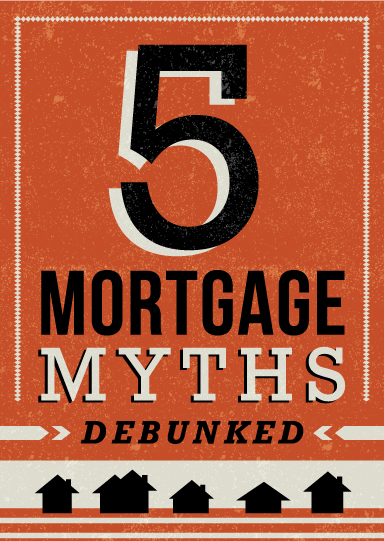You’ve probably heard your share of mortgage legends over the years. It can be hard to know what’s fact and what’s fiction. When you’re in the market for a new home, there’s no better time to learn the truth. We’ve uncovered five myths that have made their way into mainstream homebuying.

Myth #1: You must have a 20% down payment.
Fact: Today’s qualified borrowers may secure a home loan by putting down as little as 3% or 3.5% of the purchase price. If you are eligible for a VA loan, you may not need a down payment at all. Years of saving up for a down payment can sometimes be reduced to a much shorter time frame. With programs such as FHA loans or even conventional loans, those looking to secure a route to homeownership may be well on their way with a minimum down payment. NOTE: Keep in mind that if you do put less than 20% down you may have a monthly mortgage insurance payment (unless you’ve secured a VA loan). Be sure you factor that cost into your decision when planning your home purchase.
Myth #2: It’s best to pay off your mortgage ASAP.
Fact: While paying off your mortgage early might seem like a smart idea, it may not be the best use of your money. If you were able to acquire a low interest rate on your mortgage, ask a tax professional or financial advisor whether your dollars could earn more than your interest rate if you invest the money instead of paying off your mortgage early.
Myth #3: Always opt for a 30-year fixed-rate mortgage.
Fact: If you plan to stay in your home for a few decades, taking out a 30-year mortgage loan could be advantageous. But if you know you’re going to move in 5 or 10 years, an adjustable rate mortgage (ARM) loan might make more sense. In fact, with an ARM, you may be given a lower fixed introductory rate that remains locked for five or more years.
Also consider shorter mortgage terms, like a 15-year mortgage loan. While a 30-year mortgage might offer a lower monthly payment, you could end up paying a higher interest rate versus that of a shorter-term loan. By looking at different scenarios and plugging your numbers into a mortgage calculator, you just might discover a better option.
Myth #4: You need a near-perfect credit score.
Fact: While a high credit score may help you obtain a lower rate on your loan, it’s still possible to be eligible for a mortgage with a mid-level score. If you earn a steady income and pay your bills on time even though your credit might have a few bruises, you may be able to qualify. To offset the not-so-positive factors of your credit history, if necessary, you may be able to offer a larger down payment or demonstrate a low debt-to-income ratio.
Myth #5: Get preapproved and you’re guaranteed a loan.
Fact: While being preapproved is a big step in the mortgage process, it doesn’t mean you’ve secured a loan. After you make an offer on a house, the lender may check your credit again. If anything negative or any new debt obligations show up on your credit report since your preapproval, it could affect a potential loan offer. When you’re at this stage in the process, your payment history and the nature of your debts may still be scrutinized, so it’s best to avoid large purchases, such as a new car, or applying for additional credit cards.
More myths abound, no doubt. Before you take conventional wisdom at face value, it pays to do your research to separate fact from fiction. What’s more, your particular situation always plays a large role in how you obtain or set up a mortgage loan. Talk to a loan officer to learn more.



